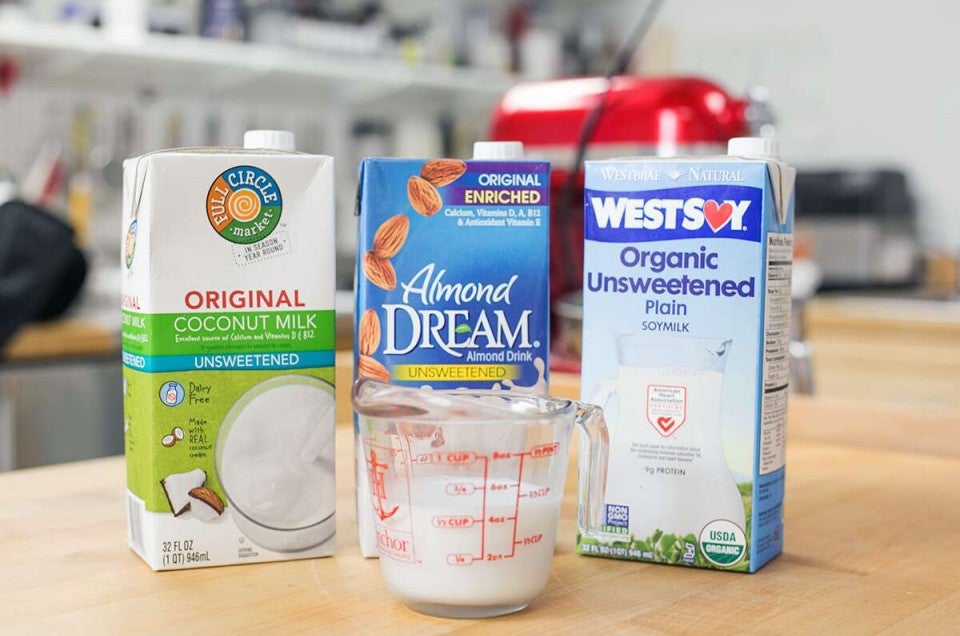What's the most environmentally-friendly plant-based milk to bake with?
Navigating the non-dairy aisle.


Like many of us at King Arthur, I’m considering the role of sustainability in my own baking — starting with the environmental impact of my ingredients and replacing cow’s milk with a plant-based milk when possible. My oat milk carton has made the leap from my daily latte to my milk of choice in freestyled pancake batter or a celebratory chocolate tart for a lactose-intolerant friend — all without a noticeable difference in results compared to dairy-based baking.
Every baker is different, and which ingredients work best for you will vary based on factors like allergies, access, nutrition, or just plain taste. Personally, I still use plenty of milk and butter in my baking, but I'm also swapping in oat milk or coconut milk in some recipes. Beyond these two options, there’s no shortage of 1:1 substitutes for dairy, and a visit to the non-dairy aisle now has everything from soy to almond to rice to hemp. So I couldn’t help but wonder: What is the best alternative milk for the planet? Is there one that’s best for the planet?
Upon searching for the answer, I quickly realized ... it depends. While the answer may not be clear-cut, it prompts deeper thought when it comes to where our beloved baking ingredients are sourced and how they’re grown, and I’ve only begun to scratch the surface on a few common alt-milks below. As environment and globalization reporter Ajit Niranjan frankly puts it in this video, “Sometimes it feels like everything you buy is somehow bad for the planet. And yeah, it often is. But some choices are better than others.”
The overarching takeaway? Plant-based milks result in fewer greenhouse gases, use less water, and require less land across the board when compared to dairy milk — so if you're looking to lower the environmental footprint of your baking, making any switch is already a good start.

Compared to crops, cows (and really any livestock, for that matter) need more maintenance, and therefore, result in higher resource usage. Starting with their feed, water is needed to grow those crops, and any transportation of those materials are also factored into dairy’s total ecological footprint. Most notably, livestock is one of the leading sources of global methane emissions.
The biggest caveat with almond milk is how much water is needed to make it. Like other tree nuts, almonds are a water-intensive crop. On top of that, domestic almonds are primarily grown in drought-prone California. Findings from a 2019 study show that one California-grown almond takes an average of 3.2 gallons to produce; while a lifecycle assessment confirms that water usage is the most significant source of almond milk’s global warming potential.
Niranjan puts it into perspective with everyday measurements from a University of Oxford study: a single 200-milliliter glass of almond milk takes about the same amount of water to produce as you would need to take a shower, about 74 liters. (In contrast, cow’s milk requires 124 liters to produce the same amount.)
Legumes, which include soybeans, are a crop that emits some of the lowest amounts of carbon dioxide. Bonus: soy milk is also our Test Kitchen’s favorite vegan “egg” wash. However, soy production is intertwined with meat production because it’s a leading ingredient for animal feed — which in turn requires large land masses (in particular, leading to the deforestation of the Amazon rainforest) to keep up with the high demand for meat.
However, not every soybean harvested contributes to these land issues. “Doing a bit of research and reading the carton can help you find products that come from Canada or the USA and help support ethical practices,” recommends AsapSCIENCE co-creator Mitchell Moffit in this video. In other words, transparent sourcing information can help us consumers choose sustainably grown soy products.

Oat milk gets high marks for its relatively low emissions, land use, and water usage, even when compared to other plant-based milks. At first glance, this may be the “best” option. Remember as an agricultural product, you can choose an organic option to be extra mindful toward sustainability.
Similarly, coconut’s emissions and water usage remain low, which makes it a solid contender as a reigning plant-based milk. There is, however, a broader impact as you zoom out to consider global consumption and growing demand for coconut and coconut-based products.
As coconut milk’s popularity grows, it has ripple effects on the supply chain. This includes deforestation in tropical regions, diminishing yields that lower farmer wages, and inequitable labor practices. Because of the complexities of supply chains and changing environments, ethical sourcing isn't always easy or straightforward. One thing consumers can do is identify brands that are fair trade, meaning the product meets sustainable social, environmental, and economic standards.

While comparing several vegan milks, Niranjan explains, “The research shows that soy and oat milk have the smallest environmental footprint. They take little water to grow and have low emissions.” That said, he emphasizes, “compared to cow’s milk, the differences between these vegan milks are pretty small. And the range of plant milks available makes it more likely people will find one they like.”
Ingredient choice is personal for every baker, but ultimately, if you’re looking to replace your cow’s milk in baking with a more sustainable option, any plant-based milk can accomplish that.
For me, what started as just a one-off experiment with pancake batter to use up a carton of oat milk opened up a much broader perspective of what it really means to bring sustainability into my own baking. Will I be an exclusively vegan baker moving forward? Nope, but I'm making choices that work for me and my baking when it feels right — starting with a single swap.
Cover photo by Anne Mientka.

